96 How to Use the Pressbooks Directory
The Pressbooks Directory (https://pressbooks.directory) provides an index of thousands of public books published across dozens of PressbooksEDU networks. This chapter will show how to navigate around the directory and find the resources you are looking for.
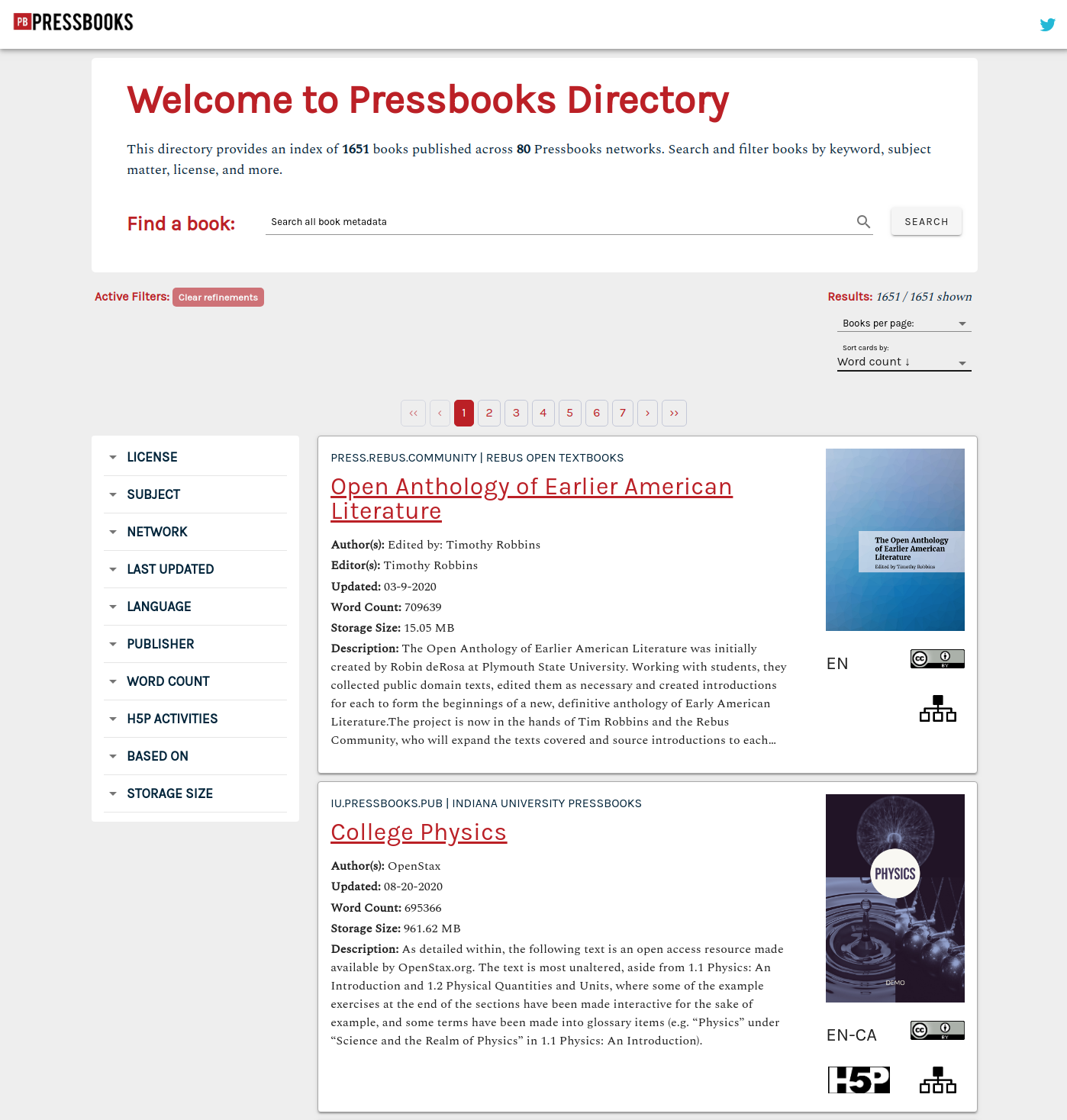
Search & Navigation tools and using the Pressbooks Directory
The Pressbooks directory is designed to help people quickly find desired resources, no matter whether they are looking for a specific book or multiple resources spanning one or more topics. You can use faceted search/filtering, full-text search, and various sorting and display options to help you find what you’re looking for.
By default, the Pressbooks Directory will include most public books on your network, though individual authors can choose to exclude their public books from being listed in the directory. To learn more about how to opt-out of inclusion in the directory, see these instructions.
Sorting search results
Underneath the number of results, you will see two options for organizing the view of your search. The custom sorting that you decide on will work concurrently with the Active Filters.
Search Bar

The search bar allows you to search the full text of all available metadata for the book. Search terms (strings) must be at least three characters long and can contain partial phrases: the query ‘medi’ will return results containing the words ‘media’, ‘medicine’, or ‘medical’, for example. If multiple strings are entered, an implicit AND operator will be added, meaning that results will only be shown if they contain each of the terms used in the query. Most languages support some degree of ‘typo tolerance‘, which means that results will be displayed for phrases/words if even they have minor differences in spelling or spacing.
To search for an exact phrase, enclose the full phrase in quotation marks: i.e. “open education”. Typo tolerance is disabled for terms enclosed in quotation marks. These queries are not case sensitive.
To exclude a string or phrase from the results, use the ‘-‘ character just before the term you wish to exclude (this acts as a NOT operator). For example, the query ‘writing “open education” -pedagogy’ would return all of the records which contain the word ‘writing’ AND the phrase “open education” but NOT the word ‘pedagogy’.
Some of the metadata facets can be searched explicitly via the search bar through the use of a specific prefix. Fields which support this feature include subject (subj:’query’), language (lang:’query’), network (net:’query’), and publisher (pub:’query’). If you wanted to find all of the English language books published by the Rebus Community on the Rebus network with a subject containing the word philosophy, you could use the following query: ‘lang:English pub:”Rebus Community” net:Rebus subj:philosophy’.
Each specific search query or combination of filters generates a unique URL in the browser bar which encodes the specific query values. For the search query given above, for example, the URL which will reproduce this query is https://pressbooks.directory/?q=lang%3AEnglish%20pub%3A%22Rebus%20Community%22%20net%3ARebus%20subj%3Aphilosophy. Query URLs can be bookmarked, saved, and shared to allow anyone to recreate your specific query at some future time and retrieve dynamic results at the time that they input the URL.
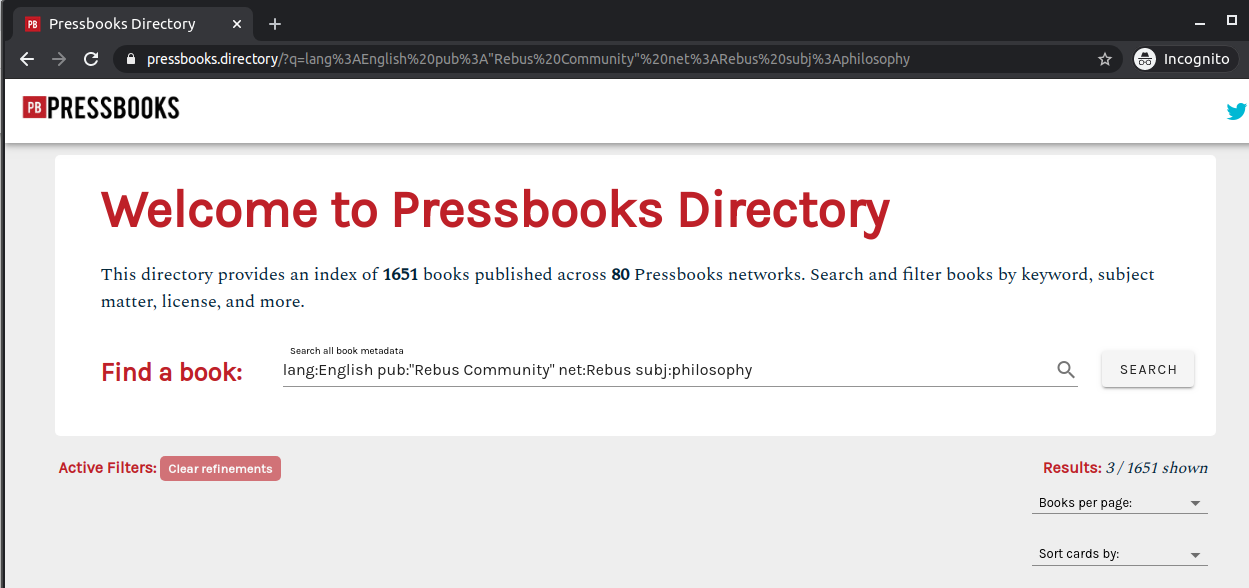
Filters
In addition to the free search tool, you can also use filters/faceted searching to refine your results. Each of the discrete filters can be used in conjunction with one another, and multiple options can be selected for each of the filter values. When multiple options are selected within a single facet, they act as an OR operator. With the dropdown option filters, you will get the choice to explicitly include them or exclude them from your search.
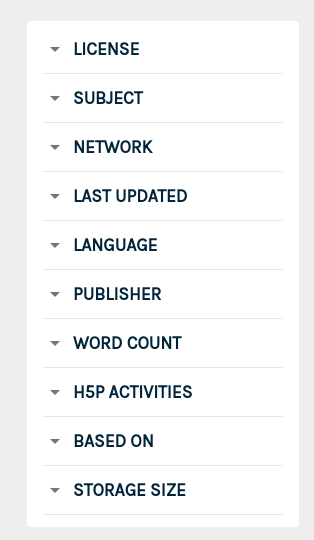
Filter Types and Usages
- License: Dropdown selector with different copyright licenses which are options on Book Info*
- Subject: Dropdown selector with different subjects which are options on Book Info*
- Network: Dropdown selector with all Pressbooks networks whose book(s) are included the directory. The number of books they have in the directory will show up next to their network name. These correspond with the network name on the bookcard.
- Last Updated: Date selector using calendar dropdowns for ‘From’ and ‘To’ to choose the date range within which a book (or its metadata) was last edited by its creator.
- Language: Dropdown selector with different language options which are options on Book Info*
- Publisher: Dropdown selector with all the entities which have been explicitly entered as a Publisher on Book Info, with the number of books available on the directory from the publisher next to their name. This is an optional field on Book Info, and many books are published without an explicit publisher.
- Word Count: Input boxes for range of minimum to maximum number of words in a book
- H5P Activities: Input boxes for range of minimum to maximum number of H5P activities in a book
- Based on: Provides the option to select to select or remove cloned books
- Storage size: Input boxes for range of minimum to maximum size of a book in Megabytes (MB)
*If you do not see an option in the selector but it exists as an option in Book Info, it means that a book which falls in that category has not yet been included in the directory.
Clearing filters
When filters start being applied, they will show below the search bar, under Active Filters. On the right hand side of the page, you will see the number of results which correspond with these active filters. Furthermore, the number of results will automatically adjust as filters are added and removed.

To remove a specific filter, simple click on the name of the applied filter. To remove all refinements, click on Clear refinements next to Active Filters.
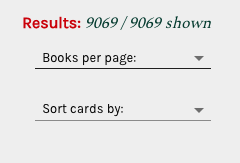
Books per page: By default, there 10 results/book cards are shown per page. This selector allows you to display 10, 20 or 50 results per page.
Sort cards by: By default, the books are listed in alphabetical order (A-Z). This selector will give you the option to choose from one of three sort options: Alphabet (A-Z), Word Count (in decreasing order) and Recently Updated (most recent to least recent).
Book Cards
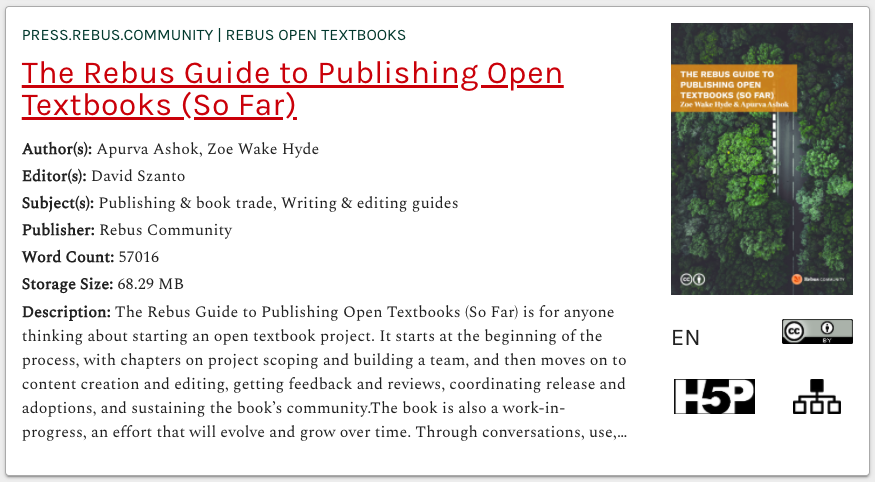
Each book on the directory is represented with a book card (shown at right). These cards provide key information (metadata) about each book and its location, and the title itself includes a link which will take you directly to the public webbook it describes to explore further.
Each component of the book card has been labeled and explained below.
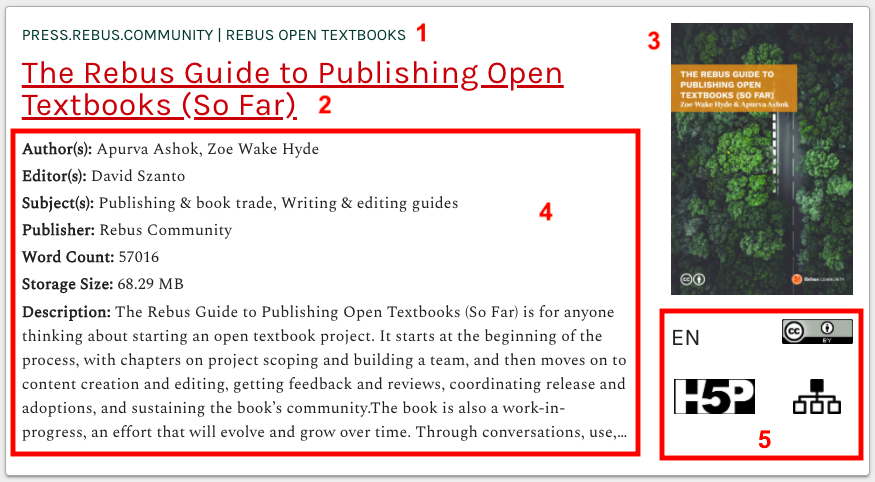
1. Book’s root network
This line provides you with information about the Pressbooks network where the book has been published. This line is split into two parts, divided by a vertical bar: the network’s root domain (URL) is printed to the left of the ‘|’ and the network’s name is printed to the right of the ‘|’.
2. Book title
This is the title of the book. Upon clicking on it, you will be taken to the webbook’s home page.
3. Book cover
The book cover is shown as it appears on the book’s homepage.
4. Book metadata & description
This section includes several metadata fields for the book as well as its description. Most of this information comes directly from the ‘Book Info’ entered in the book itself, and is automatically changed and updated in the Directory shortly after the metadata for the book itself is changed. Where this information is available, this section of the book card will include the following:
- Author(s)
- Editor(s)
- Subject(s)
- Publisher
- Word Count
- Storage Size
- Description
5. Key Information
There are four visually intuitive buttons here which allow quick identification of the contents in this book: Language, License, H5P activities and Originality.
- Language: This is the language of the book which has been set in Book Language. Keep in mind that even if the book is not written in English, if the Book Language (in Book Info) is not set to the correct language, this will show up as English.
- License: This is the license of the book that was selected in Book Info. Though the button itself indicates to which license it is, you can hover over it to see larger and more accessible print.
- H5P activities: To see how many H5P activities are in this book, hover over this button. If this book does not have any, there will be no H5P button on the book card.
- Originality: This button shows whether this book is an original or was cloned from another Pressbooks title. If the ‘parent’ position is filled, it means that this book is an original (as is the example bookcard above). Conversely, if the ‘child’ position is filled, the book is a clone. To confirm, hover over this button and a description will show indicating which position this book is.

